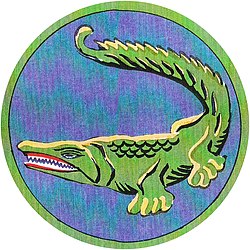| Name | Service | Notes | Commanders | Photo |
|---|
| INS Hanna Senesh (Sh-29) | 1948–1951 | In Operation Ben Ami, a force from the Carmeli Brigade landed in the captivity of Zion and evacuated the families of kibbutzim the Western Galilee to the Port of Haifa. Brought a force from the 22nd Battalion of the Carmeli Brigade to raid the Litani bridges - "Operation Kathriel" which was canceled due to the entry of the first ceasefire (June 11, 1948) | Israel Averbuch
Shaul Avni |  |
| 2 British tank landing crafts | | Length 48 meters, width 9 meters, thrust 300 tons, 3 propellers, 10.5 knots. Charger: up to 5 tanks weighing 30 tons; or 3 tanks weighing 50 tons; or 9 trucks; or 250 tons. | |  |
| INS Nevertheless | July 1948 – 1958 | Originally a missile boat LCT(r)-147 landing Battalion training, during the Tripartite Aggression. It was planned to land a force in the Gaza. [3] The landing craft is on display at the Israeli Navy Museum | | 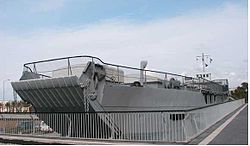 |
| INS Gush Etzion (F-39) | July 1948 – 1957 | Originally tank landing craft LCT-256, also known as "Perto". It practiced landings on the shores of the Mediterranean Sea (1949) during training exercises. | |  |
| 2 German tank landing crafts | | Length 36 meters, width 10 meters, thrust 300 tons, 3 propellers, 10 knots. | | |
| INS Yad Mordechai (P-25) | 1948–1957 | | |  |
| INS Beit Arava (P-33) | 1948–1957 | | | |
| 2 American amphibious craft | | Length 48.5 meters, width 8.5 meters, displacement 387 tons, 2 propellers, 14 knots. | | |
| INS Ramat Rachel (P-51) | December 30, 1948 – 1960 | Collection of war booty from the Sinai coast and the capture of the MiG-15 from the Lake Bardawil and the Battle of the Chinese Farm. | Hadar Kimchi
Yehuda Ben-Zur
Meir Lubochinsky |  |
| INS Nitzanim (P-53) | December 30, 1948 – | | |  |
| 6 American Tank landing craft | | Length 15 meters, width 4.3 meters, thrust 60 tons, 2 propellers, 11 knots. They were used to transport AMX-13 tanks. | | 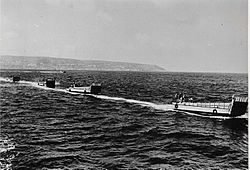
 |
| INS Machs (32,38 & 40) | | Security patrols and Operation Kinneret | |  |
| 4 Amphibious Assault Ships | 1949–1967 | Two ships assisted by providing cover from the during the battle of Taba. Four ships assisted the 9th Brigade's advance along the Sinai coast. [4] | Gad Asher |  |
| 3 36m Landing Crafts | | length 36 meters, width 6 meters, displacement 122 tons, 2 propellers, 10 knots and can carry two tanks or five BTR APCs | |  |
| INS Etzion Geber (P-51) | March 1962 – 1982 | Participated in Operation Raviv Was transferred to the Mediterranean Sea during the 1982 Israeli invasion of Lebanon, was returned to Eilat for decommissioning, remained in Eilat and was used as a base for fish farming. It was transferred to Letron in October 2016 for conservation. [5] | Rabbi Chaval Yitzchak Aharonovich, Yosef Harari, Ehud Aral, Uri Sela, Israel Petchnik, Yigal Bar Yosef, Yaakov Abarshi, Shoki Bornstein, Mordechai Dekel, Moshe Miller | 
 |
| INS Caesarea (P-53) | October 15, 1964 – March 1983 | Operation Raviv was transferred to Ashdod by land, returned to Eilat via the Suez Canal and transferred again to the Mediterranean Sea during the 1982 Israeli invasion of Lebanon | Yaakov Nitzan, Shmuel Shabach, Yosef Diamant, Shaul Horev, Yossi Levy, Hugo Shimron, Haim Markowitz, Gershon Neve, Yaron Goldstein, |  |
| INS Shekmona (P-55) | May 13, 1965 – March 1983 | Operation Raviv | David Ezer, Aryeh Harel, Shmuel Sharig, Tsiki Hakhalai, Arie Amitai |  |
| 3 60m Landing Craft | | Length 60 meters, width 10 meters, displacement 730 tons, 3 propellers, 10.5 knots can carry 6 Centaurion tanks or 16 APCs | |  |
| Tamsah (SG 20) | War of Attrition | An open barge consists of 20 floating units and is driven by two external engines. | Combat Engineering Corps (Israel) |  |
| INS Ashdod (P-61) | March 23, 1967 – | The June 1967 war and 1982 Israeli invasion of Lebanon, sold for commercial use | Yaakov Nitzan, Yosef Harari, Avi Rothman, Moshe Levy, Nimrod Gilad, Michy Ringert, Danny Carmeli, Rafi Binyamin |  |
| INS Ashkelon (P-63) | May 19, 1967 – | Six Day War, Shayetet 13 assault on Port Said in Operation Lady, sold to Eritrea | Yaakov Nitzan, David Ezer, Gabi Shilo, Amnon Tadmor, Nati Motoki, Omer Levbi, Udi Yoshua |  |
| INS Akziv (P-65) | June 1967 – | Operation Birds of Eden, participated in the 1982 Israeli invasion of Lebanon, later sold to Eritrea. | Shmuel Shevah, Shamai Bar-On, Reuven Paamoni, Avi Shaf, Omer Levbi, Udi Yoshua, | 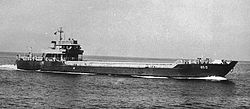 |
| MS AMALIA | June 1967 | Temporarily leased from a Greek owner during Six Day War | R/H Rami Zolberg | 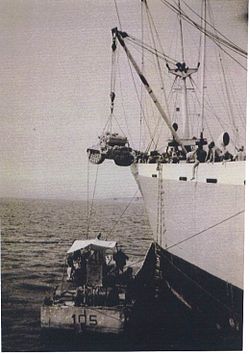 |
| INS Bat Yam (T-83) | 1968– | Originally a Dutch merchant ship, displacement 1250 tons, speed 10 knots, shot down an Egyptian plane during the Yom Kippur war. Sailed to South Africa and refueled a pair of Saar 2 ships in Operation Beauty | Rabbi Uzi Tzulof, Rabbi Aharon Marni, Mike Elder, David Atzmon, Moshe ben-Yashi, David ben Bashat, Yehoshua Marom, Raphael Zandberg | 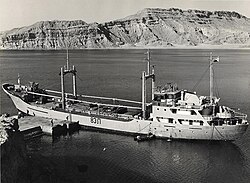 |
| INS Bat Galim (T-81) | 1968–1970 | Originally a Dutch merchant ship, length 80 m, width 16 m, displacement 2500 tons, speed 9 knots, crew 35 people, sunk by Egyptian commandos in the port of Eilat | Major Zeev Ariel |  |
| 3 American LSM tank landing amphibious craft | | Length 60 meters, width 10 meters, displacement 1095 tons, 2 propellers, 12.5 knots. Capable of sailing in the open seas that saw use in the World War. The tank deck is above the waterline, a high ratio of engine power to thrust, powerful pumps for transferring water to the bow tanks, a sharp bow front door and a separate long drawbridge. | |  |
| INS Ofir (F-91) | 1970–1976 | Yom Kippur War | Arie Marmari, Yigal Bar Yosef, Zev Goldatsky, Moti Michaeli Raphael Zandberg |  |
| INS Sheba (P-93) | 1970–1976 | | Uri Sela |  |
| INS Tarshish (P-95) | 1970–1973 | Later used as a housing unit | |  |
| INS Bat Sheva (F-57) | June 1969 – 1990 | Length 95 meters, width 11.5 meters, displacement 1892 tons, 4 propellers, 11 Nozaite connection. Carrying capacity of 12 tanks Centaurion tanks in the warehouse deck and 24 APCs M-113 in the upper deck. Transported many forces during the 1982 Israeli invasion of Lebanon. After retirement it was sunk in a naval exercise | Zvi Givati, Shaul Horev, Mike Elder, Chaim Geva, Aryeh Marmari, Yossi Levy, Marom Yehoshua, Mordechai Dekel, Danny Carmeli, Gershon Neve, Aharon Shapir, Yitzchak Cremona |  |
| Gal-Noa A\M Dan | 1970 | Exercises | |  |
| INS Bat Galim 2 | March 1978 – | Made in Japan, 96 m, width 19 m, 12 knots. Engaged in Operation Moshe and landed an armored combat vehicle in the 1982 Israeli invasion of Lebanon | Major Aryeh Gabish, Major Ilan Bokhris, Major Uzi Tishel, Major Rafi Binyamin | 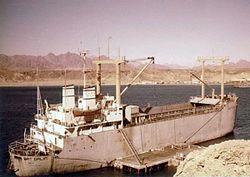 |
| A/M Yasmin | | Participated in 1982 Israeli invasion of Lebanon for the landing of an artillery group in the port of Beirut [6] | Lt. Col. Udi Aral, R/H Micha Zand, Eli Yaffe | 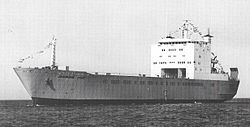 |
| INS Nachshon | August 2023 – present [7] | Israeli invasion of Gaza | |  |
| INS Kommiat | June 2024 – present [8] | | | |
|
